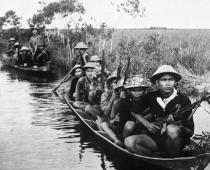An ancient impregnable city from which the Christian history of Europe began. A sea gate from Asia to Europe and a crossroads of cultures.
1. At the very dawn of its existence, Constantinople (Byzantium) was a colony in historical Thrace. It was founded by the Greeks, immigrants from Megara.
2. The first known name of the city, when it was still a Thracian settlement, was Ligos (according to Pliny the Elder).
3. Athens and Sparta fought among themselves for the possession of Byzantium. From the 4th century BC it becomes autonomous and independent from other Greek policies.
4. The Greeks called the ancient city "Byzantion". "Byzantium" is the Latinized form of the same name.
5. Byzantium possessed some of the most powerful walls among the Greek policies, and already in the earliest era withstood dozens of sieges. The art of building walls by the Byzantines was especially valued in antiquity.
6. Byzantium completely controlled the Bosporus and issued permits for passage through the strait.
7. Despite the eternal confrontation between the Byzantines and the Macedonians, Alexander the Great did not encroach on the independence of Byzantium, and during his campaigns the city remained untouched. At the same time, Byzantium even supplied ships to his army. After the collapse of the empire, Byzantium acted as an intermediary between the opposing "fragments" - the Hellenistic states.
8. In the III century BC. Byzantium became one of the wealthiest trading cities in Greece, taking over much of the slave trade.
9. Byzantium was an old ally of Rome, and even in the Roman Empire until the 2nd century retained autonomy.
10. In the Roman Empire, the city was famous for its scientists and architects, who were in demand in other cities of the Middle East and the Black Sea region.
11. The earliest Christian communities came to Byzantium. Andrew the First-Called, Stachy, Onesimus, Polycarp I and Plutarch preached here.
12. Huge destruction of Byzantium was brought not by barbarian raids or wars with other states, but by their own rulers. Emperor Septimius Severus, whom the city did not support, deprived him of autonomy, and in 196 ordered the most important buildings to be destroyed to the ground and the centuries-old city walls to be demolished. After that, for at least a century, the city was a dysfunctional province.
13. For a whole century (3rd century AD), the city was called Augustus Antonina in honor of the son of Septimius Severus - Anthony.
14. Church of St. Irene IV century - one of the oldest surviving Christian buildings and the main temple of the city to the world-famous Hagia Sophia. The Second Ecumenical Council was held in the church. It is named, however, not in honor of Saint Irina, but in honor of the "Holy Peace". "Peace" (Ειρήνη) was the name of the oldest Christian area of the city in Galata.
15. In the IV century, Constantinople was actually rebuilt and immediately as the capital of the Roman Empire. The medieval "metropolis", Constantinople, became a city of contrasts: from a simple vagabond or a soldier, one could rise to the emperor. Nationality and origin did not matter much. The luxurious palaces of the elite side by side with the miserable shacks of ordinary people.
16. The first name of the new capital of the Roman Empire - "New Rome", given to Byzantium in 330, did not take root. The city began to be called in honor of Constantine I - Constantinople.
17. In the era of the first Christian emperor Constantine I, pagan temples continued to be built in the city, which was encouraged by the authorities.

18. If the Romans' favorite place of spectacle was the Colosseum, where gladiator fights took place, then in Constantinople such a place was the hippodrome, where chariot races were held. The hippodrome was used for all major celebrations and celebrations.
19. The most valuable material in Constantinople was porphyry. In the porphyry hall of the Imperial Palace, future legitimate rulers were born.
20. The Russian name of Constantinople "Tsargrad" is a literal translation of the Greek "Vasilevus polis" - the city of Vasileus (monarch)
![]()
21. The kings of Constantinople collected in the city (mainly at the hippodrome) the most revered artifacts from all over the empire. This is the Serpent Column of the 5th century BC. from Delphi, Egyptian obelisk of the 15th century BC from Thebes, a statue of Pallas Athena from Troy, a bronze bull from Pergamon and many others.
22. The length of the fortress walls in Constantinople was about 16 kilometers, there were about 400 towers on them. Some walls reached 15 meters in height and 20 in depth.
23. The head of the city of Constantinople - the eparch, was the second person in the empire. He could arrest and expel from the city any person, in his opinion, representing a danger to the capital. One of the most famous eparchs was Cyrus, who ruled the city between the reigns of Constantine the Great and Theodosius.
24. At different times the city was ruled by the Romans, Greeks, Galatians, Crusaders, Genoese, Turks.

25. One of the very first monasteries in Constantinople, which laid the foundation for the monastic movement, was the Studion Monastery, built in the 5th century on the shores of the Sea of Marmara.
26. The population of Constantinople during its heyday could be up to 800,000 people.
27. Compared to Rome, there was a rather large middle class in Constantinople: almost 4.5 thousand individual houses. The rich lived in three-story mansions, the poor huddled in multi-story buildings up to 9 floors high on the outskirts of the city.

28. The main street of the city was called Mesa (single-root Russian "mezha", lat. medius) - "middle". It ran from east to west along numerous forums and squares from the "beginning of all roads" Mile Stone near Hagia Sophia to the city walls. Place of imperial ceremonies and active trade. The section from the Imperial Palace to the Forum of Constantine was called "Regia" - the Imperial road.
29. To protect against the attacks of the Slavs in the VI century, a special Anastasia Wall was built, about 50 kilometers long.
30. Greeks, Slavs, Armenians, Turks, Romans, Germanic peoples (Goths, later Scandinavian Vikings), Arabs, Persians, Jews, Syrians, Thracians, Coptic Egyptians lived in Constantinople. Because of the numerous pilgrims to Jerusalem, there were many hotels in the city.
31. Constantinople "fell" even before its official fall in 1453 from the capture of the city by the Turks. In 1204, during the Fourth Crusade, the Venetians burned two-thirds of the city's buildings. The most magnificent buildings and structures, including the Forum of Constantine, the baths of Zeuxippus and the surroundings of the Great Palace, lay in ruins. The capital was completely looted, including the sarcophagi of the emperors.

32. After the capture of Constantinople (1204) by the Crusaders, French became the language of the urban elite.
33. In the last two centuries of the existence of Byzantium, in the suburbs of Constantinople, Galata, a Genoese city grew up, surrounded by a wall, and dictating its own rules for trade.
34. Throughout the history of the Byzantine Empire, Constantinople was besieged 24 times. Half of the defenders of Constantinople in 1453 were Latins (Venetians and Genoese)
35. Many Russian rulers dreamed of conquering Constantinople, from Prophetic Oleg and Igor Rurikovich to Catherine II (Greek project) and the last Russian emperor. Catherine II named her grandson Konstantin.

36. Hagia Sophia - the heart of Constantinople, the largest temple in the Christian world. It was first built in 324-337, but burned down in 404, the new basilica built on this site burned down already in 532. The construction of a new grandiose temple in the VI century was carried out by Justinian I. During the Ottoman rule, four minarets were added to it, and the cathedral itself was turned into a mosque. Now the Hagia Sophia Museum. In the cathedral, the division of the churches took place, and the Shroud of Turin was also kept.
37. The Turks did not rename Constantinople after the capture. There are several versions of the origin of the word Istanbul (in the original - Istanbul): from the "Constantinople" distorted by the Turks to the Turkish adaptation of the everyday name "polis" ("city" as City, capital), to which "extra" sounds were added (other examples: Smyrna- Izmir and Nicomedia-Iznik). It is known that the Arabs used the name "Istinpolin".
In any case, in official documents until the 20th century, the city was referred to in the Arabic manner as Constantine.
38. During the Ottoman period, a new “city within a city” arose in Galata, with a Christian majority. Merchants settled there - Greeks, Armenians, Italians. The first Central Bank was founded in Galata. The area was also called Pera, which means "beyond".

39. The most famous square in Istanbul - Taksim is located on the site of the largest non-Muslim cemetery (of the Armenian community), founded in the 16th century.
40. Constantinople during the Civil War in Russia became the main gate of the white church and civil emigration. About 200,000 Russian emigrants were accommodated in the city and its environs. By the mid-20s, the bulk of them repatriated to the USSR, emigrated to European countries (Yugoslavia, Bulgaria, Czechoslovakia) and the countries of America, some died of disease and starvation, forced to live on islands and territories deprived of material support.
- In contact with 0
- Google+ 0
- OK 0
- Facebook 0








